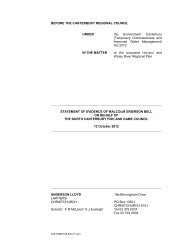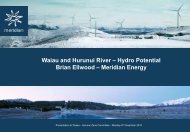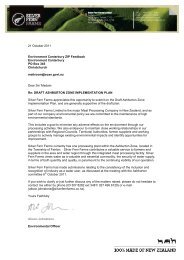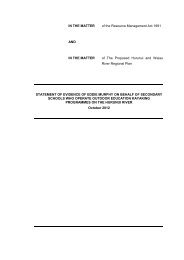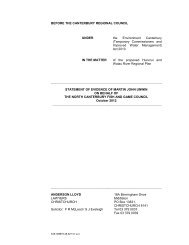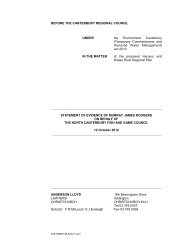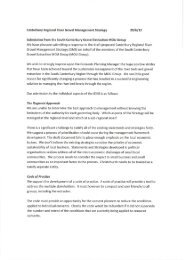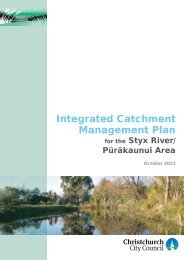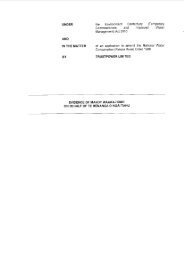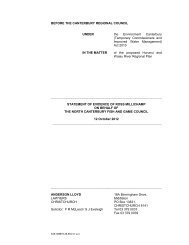Geological contours for groundwater modelling, South Canterbury
Geological contours for groundwater modelling, South Canterbury
Geological contours for groundwater modelling, South Canterbury
Create successful ePaper yourself
Turn your PDF publications into a flip-book with our unique Google optimized e-Paper software.
an absence of data rather than direct evidence of simplicity and it would not be surprising ifthere is structural complexity beneath the coastal plain. Several bore logs within a fewkilometres northwest of Makikihi report mudstone lithologies that may potentially be indicativeof Motunau Group at relatively shallow depths. An exposure of fossil marine shells in KowaiFormation near Makikihi (NZ Fossil Record File: J40/f0041; also see Gair 1961) containsspecies that are diagnostic of only a broad age range spanning from latest Miocene toearliest Quaternary, which equates to the entire age span of the Kowai Formation (Field andBrowne 1986). There<strong>for</strong>e, we do not know whether the fossiliferous horizon at Makikihi lies inthe lower, middle or upper part of Kowai Formation, and thus no light is shed on the presenceor otherwise of structural complexity in the Makikihi area. In the interests of minimisingspeculation, we assume that the mudstone lithologies in bore logs near Makikihi are part ofKowai Formation and that the geological structure in this area is simple. However, if futuredata give reason to suspect geological complexity in this area, it would be well worthconsidering the possibility that the Brothers Fault extends southeast towards Makikihi, downthe valleys of Teschemaker Creek and lower Makikihi River.Near the western edge of the project area west of Waimate, several faults are identified fromgeological offsets (Forsyth 2001). Basement is exposed in some places on the upthrownsides of these faults and, along with measured bedding dips, allow basement <strong>contours</strong> to bedrawn with reasonable confidence in proximity to the faults. <strong>South</strong> towards the Lower WaitakiPlain, there are fewer exposures of distinctive geological layers, few measured dips, and thuslittle reliable constraint on basement contouring. Water bores and geological investigationbores along the Waitaki valley are <strong>for</strong> the most part too shallow to provide useful constrainton the geological contouring, but a gravity survey line by Woodward et al. (2003) helps toguide the basement contouring. In general, the basement contour patterns west of theWaimate Fault, apart from in those areas close to basement outcrop, are speculative.A1.2 Contours on the base of Kowai FormationThe contour map (Fig. 5 of text) is based largely on the basement <strong>contours</strong>, by addingmeasured section stratigraphic thickness to the basement contour elevations in order to drawthe <strong>contours</strong> on the base of Kowai Formation. There is a high degree of internal consistencybecause the contact between Kowai Formation and underlying Motunau Group, as mappedat the ground surface, was a source of stratigraphic picks <strong>for</strong> defining the elevation of the topof the basement.The main divergence from this pattern is in stratigraphic sector 3d west of Timaru, wheregeological mapping indicates that the base of the Kowai Formation rests uncon<strong>for</strong>mably onolder <strong>for</strong>mations reflecting slight tilting and partial erosion of the Cretaceous-Cenozoic rocksequence during deposition of the Kowai Formation in that area (Gair 1959; Barrell 2008).The general concordance between <strong>contours</strong> on the top of basement and <strong>contours</strong> on thebase of Kowai Formation elsewhere in the project area is primarily an artefact of the methodof contouring. The contour model aims <strong>for</strong> the maximum simplicity that the data allow, and inall likelihood greater complexity may emerge as new data become available.At numerous locations on the coastal lowlands, bore holes within Kowai Formation provideminimum constraint on depth to base of the <strong>for</strong>mation, and thus maximum constraint on theGNS Science Consultancy Report 2012/245 A-5




